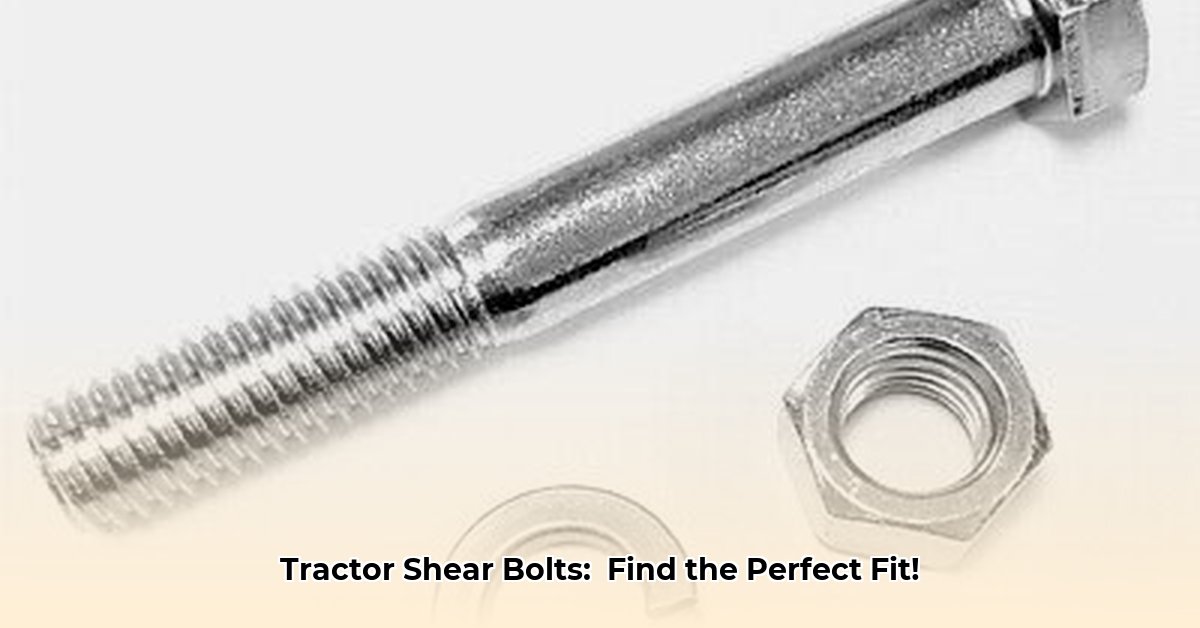
Tired of constantly replacing shear bolts on your tractor? This guide simplifies shear bolt selection, covering causes of failure, proper selection, and installation. By the end, you'll save time, money, and frustration.
Understanding Shear Bolts
Shear bolts act as safety fuses in your tractor. When a snowblower, PTO (power take-off), or other attachment encounters excessive resistance (e.g., a rock), the shear bolt breaks, preventing damage to your tractor's transmission or the attachment. This protective mechanism is crucial for preventing costly repairs.
Dispelling the Grade 8 Myth
Many believe a Grade 8 bolt is always the best choice. This is incorrect. While Grade 8 bolts excel in tensile strength (resistance to pulling forces), their shear strength (resistance to sideways force) is surprisingly lower when threaded. An unthreaded Grade 8 bolt offers superior shear resistance. Threads reduce the bolt's cross-sectional area, weakening it under shear force. Therefore, bolt grade is only one factor in selection.
Key Factors in Shear Bolt Selection
Choosing the right shear bolt involves several crucial factors:
- Bolt Diameter: A larger diameter generally indicates greater shear strength.
- Bolt Length: Sufficient length ensures proper fastening. Too short, and it won't grip adequately.
- Material Grade: Different grades (e.g., Grade 5, Grade 8) possess varying tensile and shear strengths. While Grade 8 is strong in tension, it's not always optimal for shear.
- Threads (or Lack Thereof): Unthreaded bolts typically exhibit higher shear strength due to a larger cross-sectional area.
- Expected Load: This is paramount. Estimate the maximum force the bolt may encounter. Factors such as snow type, attachment size, and operational force all influence this. Underestimation can lead to premature failure or inadequate protection.
Selecting the Perfect Shear Bolt: A Step-by-Step Guide
Identify the Application: Determine the specific location of the shear bolt (e.g., snowblower drive shaft).
Estimate the Load: Approximate the maximum force the bolt will encounter. Your tractor's manual and the attachment's instructions may provide guidance.
Consult the Manual: Your tractor's owner's manual provides recommended shear bolt specifications for your machine and attachments. This is your primary resource.
Calculate (If Necessary): While complex engineering calculations can determine ideal bolt size and grade, it's safer to rely on manufacturer recommendations if you lack the expertise.
Purchase Correctly: Source shear bolts from a reputable supplier, ensuring exact matches in diameter, length, grade, and thread type.
Shear Strength Comparison: Threaded vs. Unthreaded
This table offers a general comparison. Note: These values are approximate and vary by manufacturer. Always refer to manufacturer specifications.
| Bolt Type | Approximate Shear Strength (lbs) |
|---|---|
| Grade 2, Threaded | 2000 |
| Grade 5, Threaded | 3000 |
| Grade 8, Threaded | 3177 |
| Grade 8, Non-Threaded | 4418 |
Preventative Maintenance
Regular inspection is crucial. Examine shear bolts for wear and tear, replacing them according to your tractor's maintenance schedule. This simple practice prevents unexpected failures and potential damage. Consult a qualified mechanic if unsure about any aspect of this process.
Calculating Shear Force for Snowblower Shear Bolt Selection
Shear bolt failure frequently occurs in snow blowers due to exceeding the bolt's shear force capacity. Accurate shear force calculation requires understanding bolt material properties, dimensions, and acting forces. Incorrect selection results in equipment damage and potential safety hazards.
Understanding Shear Force
Shear force acts parallel to a bolt's cross-sectional area, causing it to break. Calculating shear force involves determining the shear area (for a round bolt: πr², where 'r' is the radius) and the bolt material's shear strength (often a percentage of ultimate tensile strength, found in manufacturer specifications). The formula is: Shear Force = Shear Area x Shear Strength.
Factors Affecting Shear Force
- Bolt Material Grade: Higher grades denote higher shear strength.
- Bolt Diameter: Larger diameter increases shear area and capacity.
- Thread Condition: Threading reduces shear area, impacting capacity.
- Snow Density and Auger Force: Snow conditions significantly affect the force exerted on the shear bolt.
Selecting the Correct Snowblower Shear Bolt
While calculations provide estimates, using a safety factor (e.g., 20%) is recommended. Always consult your equipment's manual for recommended specifications.
| Bolt Diameter (inches) | Shear Area (sq in) | Shear Strength (psi) (Example - Grade 5) | Recommended Shear Force (lbs) |
|---|---|---|---|
| 1/4 | 0.049 | 60,000 | 2940 |
| 5/16 | 0.077 | 60,000 | 4620 |
| 3/8 | 0.110 | 60,000 | 6600 |
Remember, correct shear bolt selection ensures safe and efficient tractor operation. Using the wrong bolt can cause catastrophic damage.